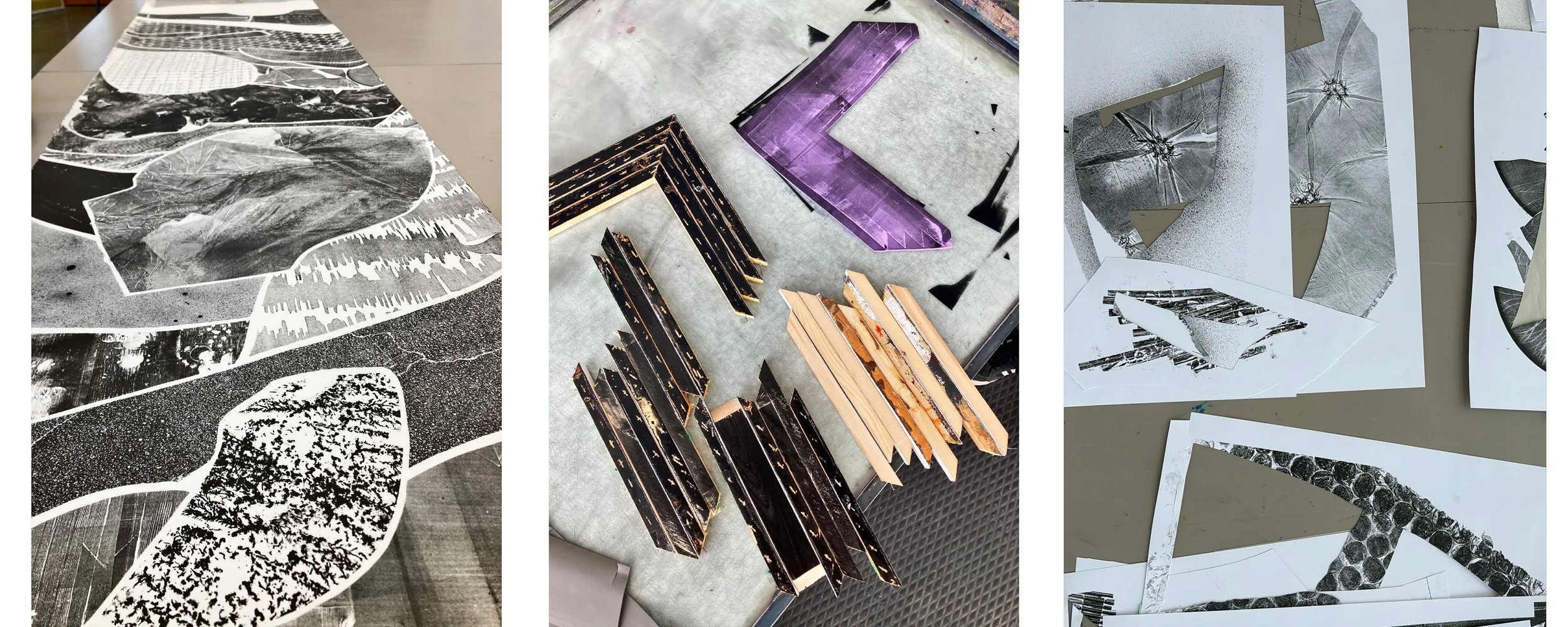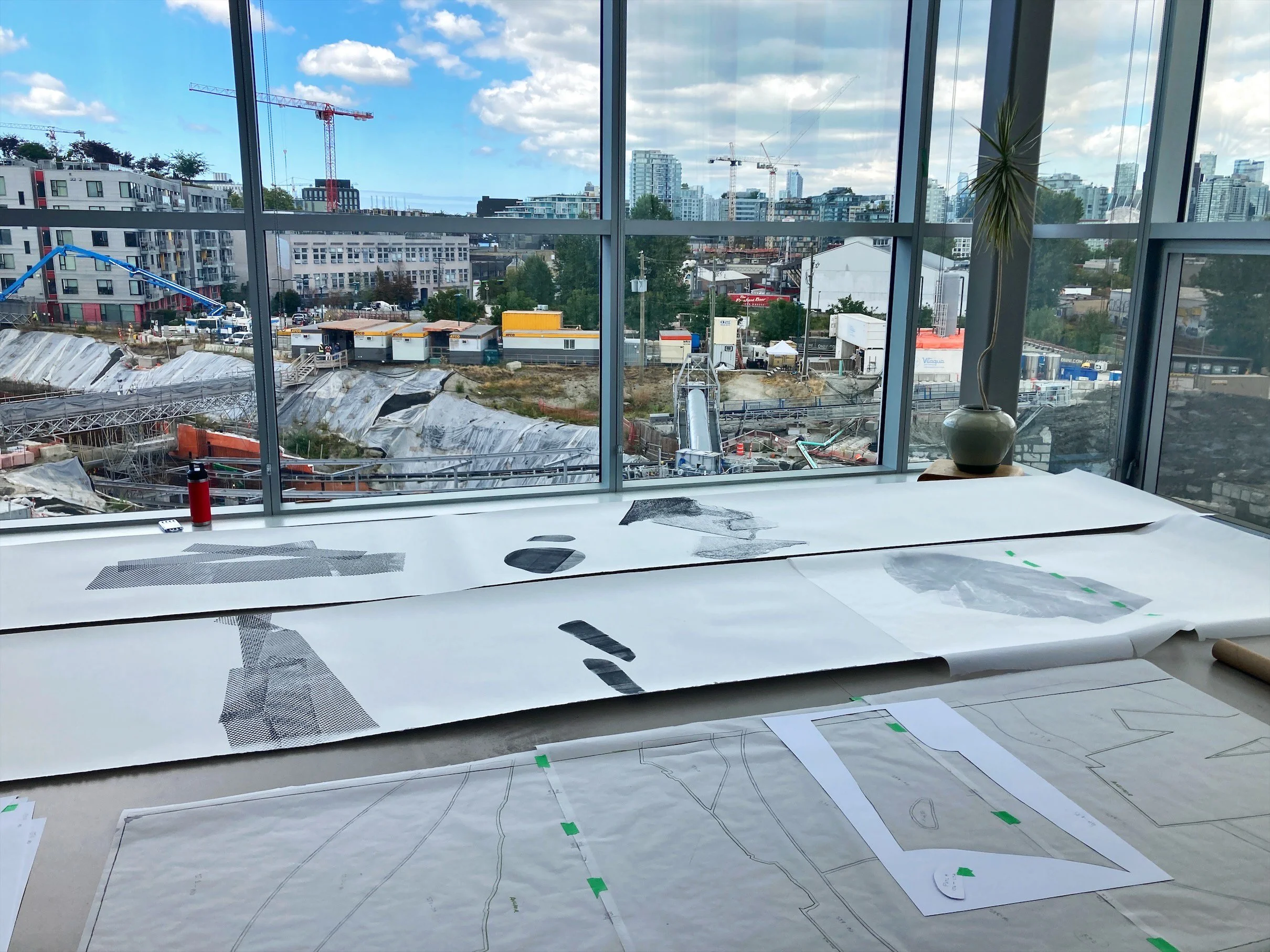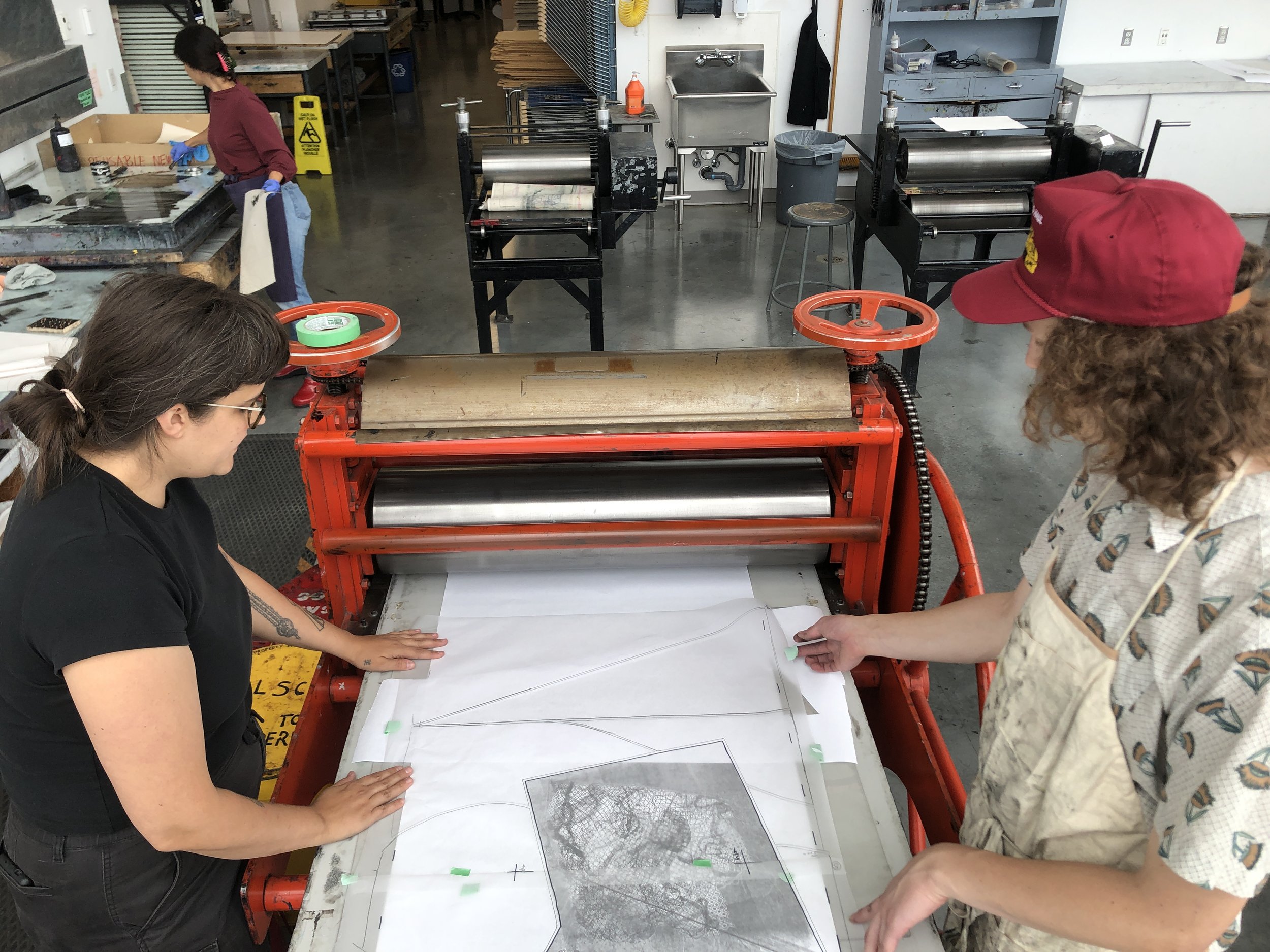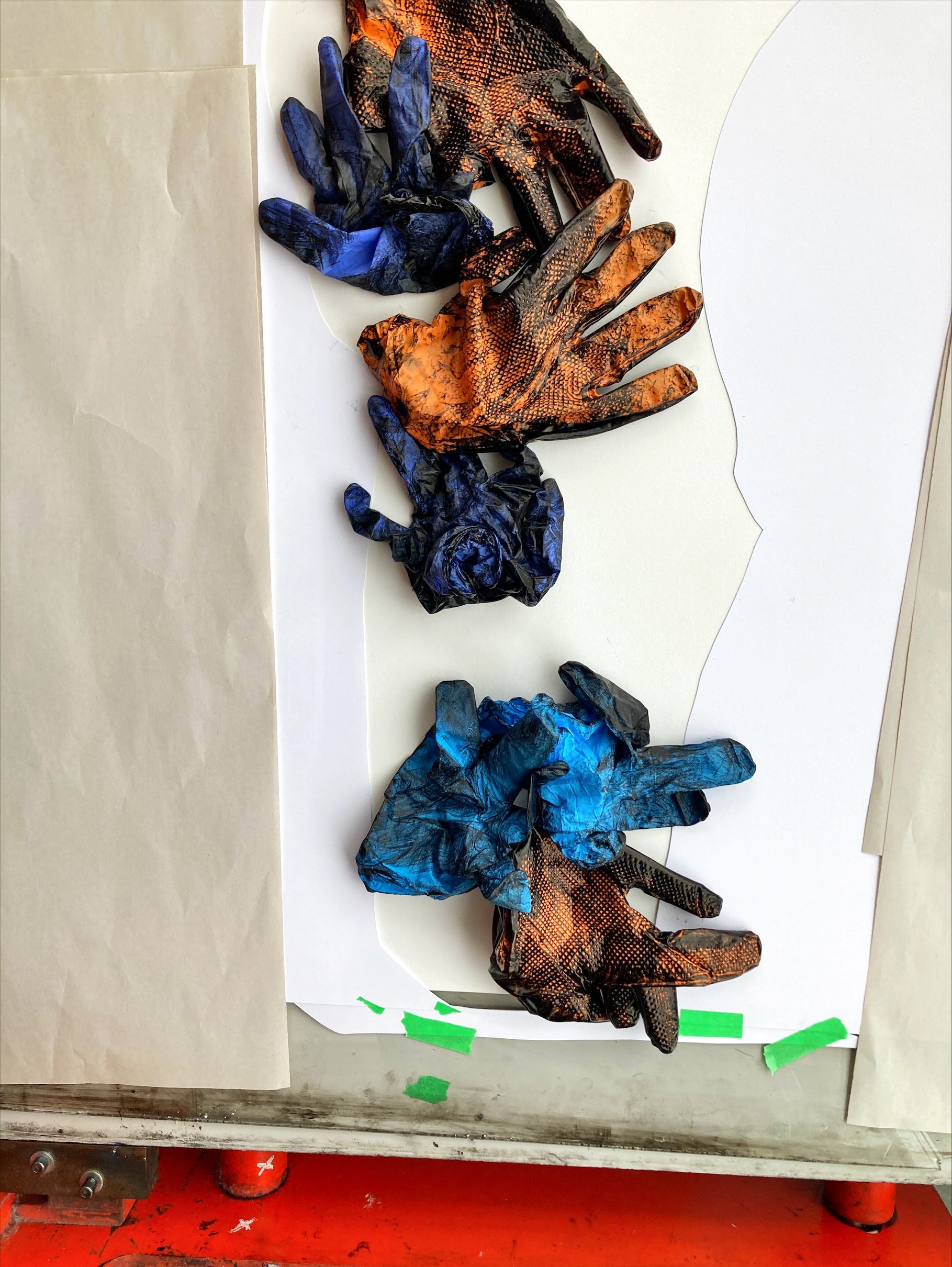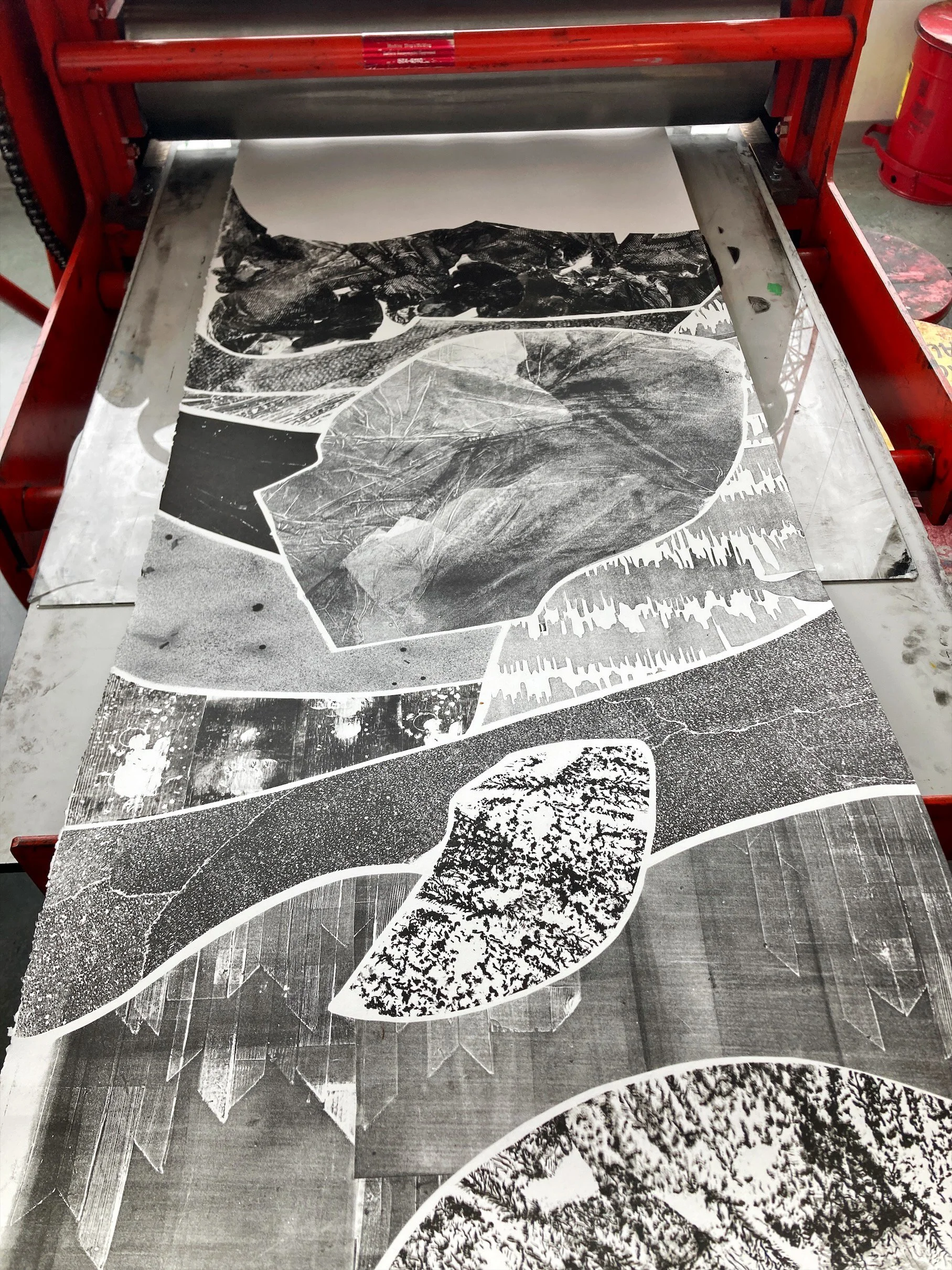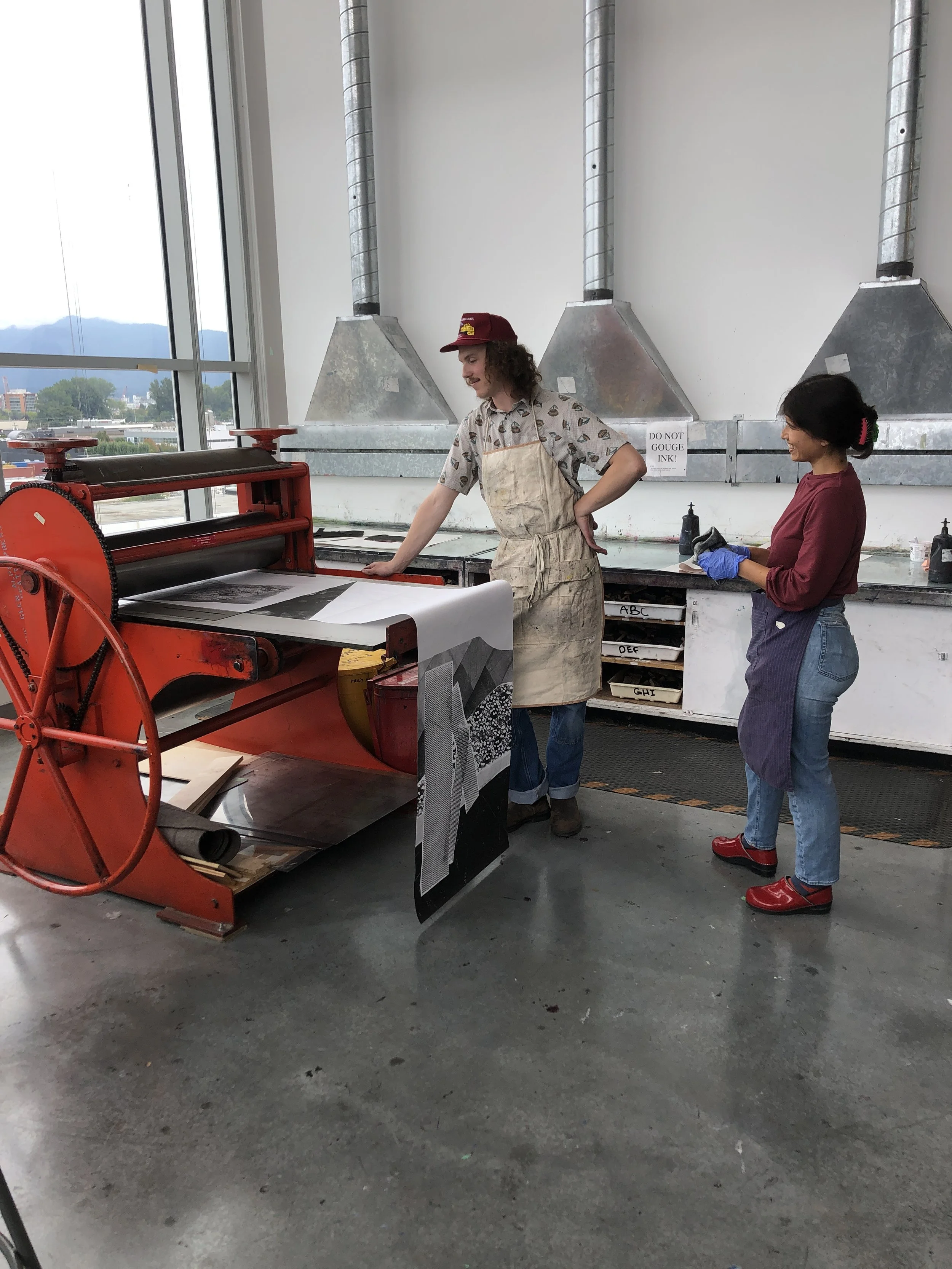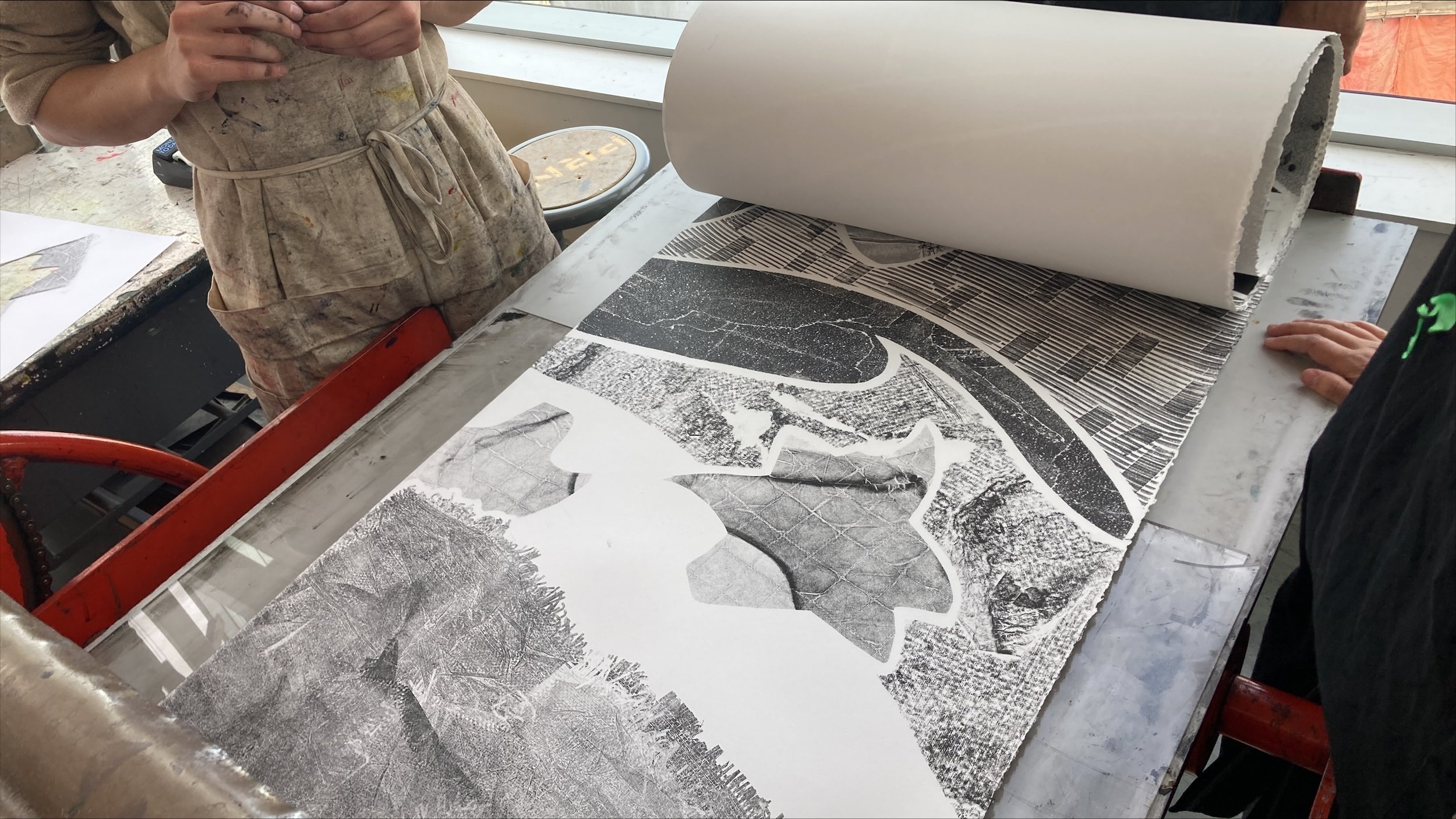PILING/UPON
SARA-JEANNE BOURGET / MIRA LOUISE D’SOUZA / MARK JOHNSEN / WILL PRICE
FEBRUARY 5-16TH 2024 / EMILY CARR UNIVERSITY OF ART + DESIGN
LOCATION
Emily Carr University of Art + Design is built on what were once tidal mudflats; part of an enormous and richly diverse saltwater marshland where water streams and the ocean met. The mudflats covered an area shared amongst txʷməθkʷəy̓əm (Musqueam), Sḵwx̱wú7mesh (Squamish), and səlilwətaɬ (Tsleil-Waututh) nations. Their stolen and unceded land host what is today known as Vancouver. According to the city’s historical timeline: In 1915, it officially began filling the mudflats with soil, landfill, and waste from surrounding development projects, factories, and industries: in short, with piles of garbage.
To account for the unstable mudflats [filled with garbage], the threat of seismic activity, and climate change, the building that hosts Emily Carr University was built upon a large concrete raft foundation over the soft soil. Before the foundation was poured, the mud-like soil was rapidly compacted by vibration to densify the land and large stone piles of loose aggregate were bored deep into the ground as vertical columns to offer stability.
While learning about the land on which our campus is situated, and the engineering methods employed to ground the building, we imagined this land pre-colonial time. We reflect on what is lost, what stories (geological, natural, human) are compacted beneath our feet, and the possible future of this place (for regeneration and reparation). We acknowledge the connections to this land that indigenous peoples fostered before they were forcibly displaced. We wonder about the piles that formed over time: A slow stacking of garbage/detritus forming the ground and the rock piles on which the stability of an entire building relies. Our horizon shifts, to consider the verticality of time and stories piling up.
PILING/UPON
In an era of overconsumption and capitalist reign, garbage is continually piling up. Rubbish is worthy of being buried, crushed, burned, and placed out of sight (when possible). Garbage is sent back to the subterranean, sublimated into fumes towards the atmosphere, or left to slowly decay. Trash finds itself in an accelerated, multi-dimensional position: It exists in flux within every stratum; from space, down to the bottom of the ocean, as an enormous vertical pile, impossible to weigh or conceptualize on a human scale. To quantify the floating (in space and ocean) and transitional amount of garbage in circulation, it made sense to minimize the scale of our project and bring focus to our location. We investigated our ever-growing pile(s) at Emily Carr University, as well as unearthing the piles hidden underground.
Our project is an attempt to visualize things/objects coming in and out of (our) view. The collective processes of creation taking place on campus consequently produce waste materials, sometimes in the form of failed or unwanted art and/or design projects. Collecting these trashed objects on campus has resulted in the creation of a [discard] pile to draw from.
CREATION FROM RESIDUE AND POSSIBLE CYCLES
Our selection process for our matrices was heavily influenced by the discarded object’s ability to be run through a printing press. With each pass of the press, objects compressed and revealed themselves as contact impressions on a long paper scroll. We devised a system to collect physical/visual information, informed by already existing scientific diagrams, such as those depicting stratigraphy and invisible geological formations underground. The lengthy scroll is evidence of a timeline of information being collected, like a seismograph recording tremors of the earth in real time. The forming of this visual record required careful planning, in the form of transparent hand-drawn maps and hand-cut stencils, helping contain and order each imprint.
The scroll was created using a large collagraph press. This rare press, one of only 80 made between 1950 and 1980 by Seattle printmaker Glen Alps, is set to be put out of commission after many years of heavy use. The pressure from the worn-out press was used to compact trash onto a stratum: a reflection of the physical ground beneath (garbage-filled mudflats) our campus.
Increasingly, the accumulation of objects we printed from took the shape of a heavy pile. We have not solved the problem arising from the formation of these passing piles of discarded objects on our campus but perhaps given extra time and longevity to a select number of things. The scroll displays its diverse texture and speaks to the endless compression of material, while merging time, cycles, creation, and experiences.
COLLABORATION
The premise of this project was elaborated on the blurring of authorship, which organically occurs through collaboration. The exchange between the artists is revealed in the development of a specific visual language emerging from a shared and communal archive. Collaboration extends to every unknowing participant who discarded the things/trash we included in the work. Lastly, collaboration with others is natural, and inevitable on a campus that sustains a rich network of knowledge and practices.
Works Cited
Maracle, Lee. First Wives Club: Coast Salish Style, Theytus Books, Penticton, B.C, 2010, p. p.13-28.
Uhl, Magali. "Marshland Revival: A Narrative Rephotography Essay on the False Creek Flats Neighbourhood in Vancouver." Visual Studies, vol. 36, no. 4/5, 2021, pp. p326-347, https://doi.org/10.1080/1472586X.2021.1876527.
Dulong, Nicole, et al. "Hogan's Alley Site Guidelines." [Re]Visiting Hogan's Alley - Vertical Studio, 12 Jan. 2022, issuu.com/sam2583/docs/hogansalleysiteguidelines_export_for_nicole. Accessed 24 Jan. 2024.
Brent B. I., Gordon. "Reimagining SkwáCháY̓S." Still Underwater, 1 Sept. 2023, www.gordonbrentingram.ca/stillunderwater/1921/04/. Accessed 24 Jan. 2024.
"The Flats / Area Profile: An Overview of Your False Creek Flats." Vancouver.Ca, vancouver.ca/files/cov/false-creek-flats-area-profile.pdf. Accessed 24 Jan. 2024.
Steyerl, Hito. "In Free Fall: A Thought Experiment on Vertical Perspective." E-Flux, no. #24, 2011, https://www.e-flux.com/journal/24/67860/in-free-fall-a-thought-experiment-on-vertical-perspective. Accessed 24 Jan. 2024.
"Emily Carr University of Art + Design." Bush Bohlman & Partners, www.bushbohlman.com/projects/emily-carr-university-of-art-and-design/. Accessed 24 Jan. 2024.
"Rapid Impact Compaction & Rapid Vibro Compaction." Farrell Design-build, www.farrellinc.com/foundation-systems/rapid-impact-compaction-rapid-vibro-compaction/. Accessed 24 Jan. 2024.
"RAFT OR MAT FOUNDATIONS." Understand Building Construction, www.understandconstruction.com/raft-foundations.html. Accessed 24 Jan. 2024.
"Keller." Vibro Stone Columns, www.keller.co.uk/expertise/techniques/vibro-stone-columns. Accessed 24 Jan. 2024.
This project and exhibition have been made possible through a SSHRC Institutional Grant (SIG) and assistance from the Research Office team at Emily Carr University of Art + Design. We would like to extend our infinite gratitude to the studio technicians: Vanessa Hall-Patch, Shinsuke Minegishi, Sharon Bailey, and Yang Hong for their help in gathering materials, knowledge, and contributions. We also extend to Michael Love, for documenting the exhibition. Lastly, we thank the numerous faculty members, staff, and students at ECU who have helped inform and create this work both through conversation and production.
We acknowledge that Emily Carr University is situated on ancient and unceded territories, shared amongst txʷməθkʷəy̓əm (Musqueam), Sḵwx̱wú7mesh (Squamish), and səlilwətaɬ (Tsleil-Waututh) nations, who cared for this land since time immemorial.

